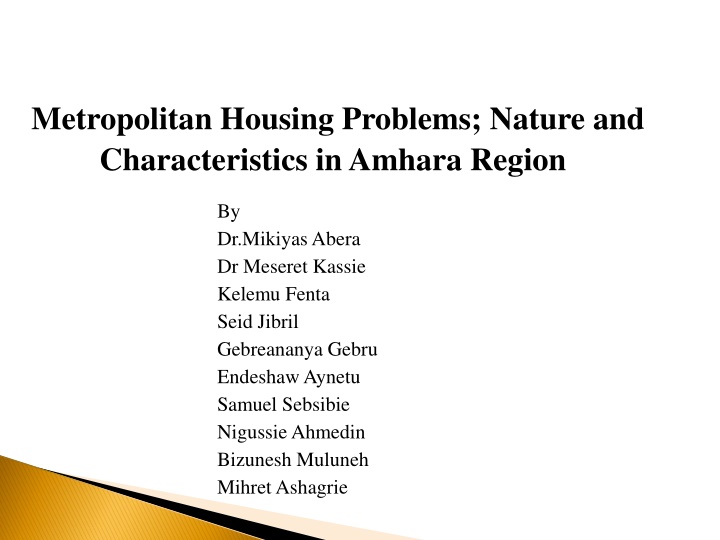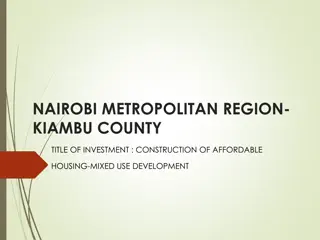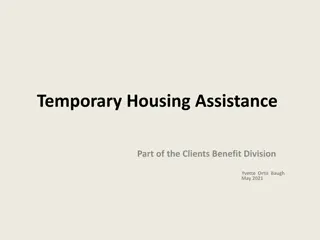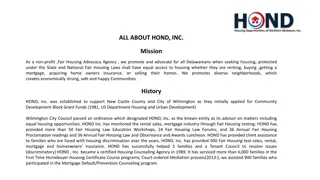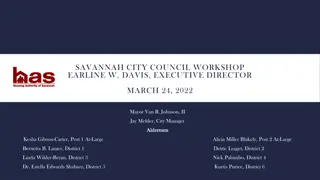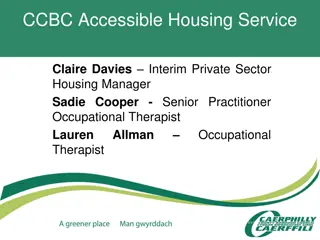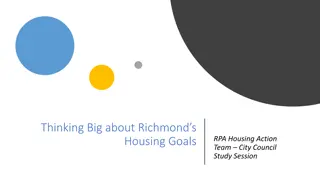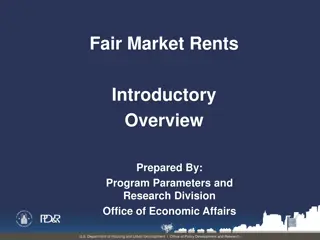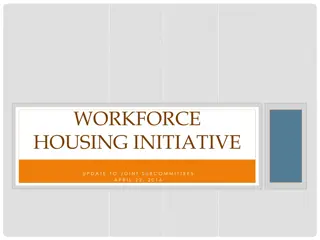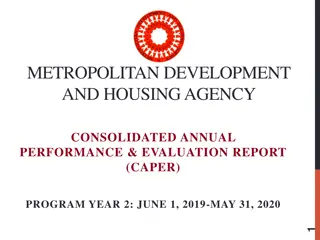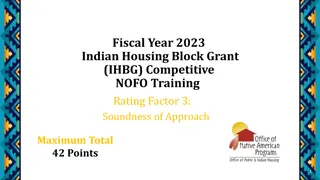Metropolitan Housing Problems in Amhara Region
"This study delves into the nature and characteristics of metropolitan housing problems in the Amhara Region, focusing on urbanization trends, population growth, and the prevalence of squatter settlements. It addresses the challenges and opportunities brought about by urbanization in developing countries, highlighting the impact on poverty and housing shortages."
Uploaded on Mar 13, 2025 | 1 Views
Download Presentation

Please find below an Image/Link to download the presentation.
The content on the website is provided AS IS for your information and personal use only. It may not be sold, licensed, or shared on other websites without obtaining consent from the author.If you encounter any issues during the download, it is possible that the publisher has removed the file from their server.
You are allowed to download the files provided on this website for personal or commercial use, subject to the condition that they are used lawfully. All files are the property of their respective owners.
The content on the website is provided AS IS for your information and personal use only. It may not be sold, licensed, or shared on other websites without obtaining consent from the author.
E N D
Presentation Transcript
Metropolitan Housing Problems; Nature and Characteristics in Amhara Region By Dr.Mikiyas Abera Dr Meseret Kassie Kelemu Fenta Seid Jibril Gebreananya Gebru Endeshaw Aynetu Samuel Sebsibie Nigussie Ahmedin Bizunesh Muluneh Mihret Ashagrie
Introduction Methods and procedure Results Conclusion
Urbanization is the process by which people are moving from rural to urban areas. The (Cohen,2003). world is increasingly becoming urban
World level of Urbanization 80% 70% 60% 50% 40% 30% 20% 10% 0% 1930 2014 world level of uranization urbation 2030 2050
The worlds population is expected to grow by 2.5 billion from 2007 to 2050. The cities and towns of developing countries absorbing almost all of these additional people (Montgomery, 2009). Urbanization brings desirable and undesirable changes.
In the third world, urbanization is caused by adverse rural conditions (Munro, 1974; Jackson, 1975; Long, 1975; Greene, 2010). It is subjugated by unplanned/squatter (Mnwuyelet, 2005).
Housing is one of the acute problems in many Third World countries and the prevalence of squatter and slum settlements are indicators of the extent of poverty and shortage of housing (Brian and Ranvinder 1995).
Urban centers have existed and have been evolving for many centuries across different parts of the Ethiopia. Rate of urbanization is grater than population growth which is 4.1% and 3% respectively (MUDHCo, 2015).
The Trend of Urbanization in Ethiopia 35% 30% 25% 20% 15% 10% 5% 0% 1960 1984 1994 2013 2025
while, the urban and construction sector of the GTP I and urban development policy of Ethiopia Emphasize on urban poverty and unemployment reduction, and Integrated housing development as key strategies areas; many of Ethiopian urban centers are characterized by multidimensional socioeconomic problems.
High urban poverty 25.7% (MoFED, 2012). Large proportion of population are homeless. Victims of social disorganization and crime. Informal economic activity (46%). sub-standard housing around 70-90%. (UN Habitat, 2008). Uninhabitable urban areas about 60% (Samson &Tiwari, 2012; (MUDHCo, 2014).
Urban centers in Amhara region are not exceptions to these problems. Comprehensive characteristics metropolitan centers are rare and fragmented. studies of on the nature of and these housing problem
General objective Investigate the nature and characteristics of housing problem of metropolitan urban centers of Amhara region (Bahirdar, Dessie and Gondar)
Study Design The study was cross-sectional and collect a body of quantitative data from urbanites in the three metropolitan centers. Data Type and Method of Collection Data was collected mainly through survey conducted on households in the study areas. Samples were selected using multistage stratified sampling.
Amhara National Regional State n=440 Stage 1: total sample households were distributed between the metropolitans based on household size Dessie n=102 Gondar n=171 Bahir Dar n=167 Ten sub cites Ten sub cites Nine sub cites Stage 2. considering population density (high, medium and low) and urban land use (residential, commercial and industrial/agricultural). Ager Gizat n=30 Sefene Selam n=41 Arada n=22 Menafesa n=50 Arada n=30 Maraki n=99 Airport n=42 Hidar 11 n=73 Ginbot 20 n=53 Stage 3. households were selected from each sample sub-cities using random sampling technique.
Parametric and non parametric statistical techniques were employed to analyses the data using (SPSS) version 20.
Results and Discussion Basic Socioeconomic Characteristics Cities Variables Gondar City 41.77 [171] 1814.5 [169] 10.65 [152] Bahir City 45.32 [167] 2934.2 [167] Dar Dessie City Average ( [n]) Age**** F=14.54 Average Income***F=5.83 ( [n]) 35.81 [100] 41.76 [438] 2487.0 [102] 20.72 [43] 2398.0 [438] 15.6 [248] ( [n]) Number of years in the city [for migrants]****F=26.01 25.72 [53] ( [n]) ( [n]) Household size Approximate schooling of the HH head 4.6 [166] 8.5 [171] 4.6 [164] 8.4 [167] 4.7 [101] 8.0 [102] 4.5 [431] 8.4 [440] years of ( [n]) ISEI Status**** F=8.32 Occupational 47.7 [171] 43.1 [103] 39.9 [99] 44.3 [373] ****sig at .001; ***sig at.01; **sig at .05; *sig at .1 [Source: Survey, 2016]
Residents at Gondar spent about 56% of their earning in the form of rent as compared to residents of Bahir Dar( 18%) and Dessie (43%) . Housing is considered affordable to a household if the rent (including utilities) is no more than 30 % of its income. Households spending more than 30% and 50 % are labeled cost burdened and severely cost burdened (Belsky & et al, 2005).
Average number of rooms in a housing unit in each city was not statistically significant (F=.14; =.24); and the average was found to be 3 rooms. Relatively, housing units in Bahir Dar have greater number of rooms followed by Gondar.
There is significant variation between the cities in terms of households hosting kitchen ( 2=16.50; =.001), in favor of the city of Gondar, and bathroom ( 2=32.99; =.001) in favor of Bahir Dar. But, variation between housing units in terms of hosting toilets was insignificant ( 2=3.95; =.14).
78% of the households reside in Villas, while 21% and 1% of them resided in condominium and apartments respectively. The overwhelming majority of the residents of Dessie lives in Villas (95%), while 78% and 69% in Bahir Dar and Gondar. (31%) of residents from Gondar, (21%) Bahir Dar and(5%) Dessie occupied condominium.
Ownership Status by City of Residence 69 privately owned rent from gont rent from private 70 60 49 50 41 37 40 26 25 30 22 18 20 13 10 0 Dessie Gondar Bahir Dar
81 % housing units at Dessie, 52% at Gondar and 43% Bahir Dar had their walls made of earth/wood. (14%) in Gondar, (11%) in Bahir Dar and (10%) in Dessie of housing units walls made of Stone with Cement/Mud-plaster. Most housing units in Bahir Dar, had their walls made of blocks and cement than Gondar and Dessie ( 2=45.48; =.001).
Gebeyehu & etal 2001 survey 2016 48 47 50 40 33 30 13.9 20 10.8 8.9 10 0 Bahir Dar Gondar Dessie
Housing roofs from thatch 12.9 14 Gebeyehu & et al (2001) Survey 12 10 8 6 3.5 3 2.5 4 2 2 0 0 Bahir Dar Gondar Dessie
Neighborhood congestion is the most reported problem by the residents of Gondar (51%) as compared to Bahir Dar (42) and Dessie (39). Pollution is (32%) in Gondar, (49%) in Bahir Dar and (52%) Dessie. Quite lower than the country s average urban slum areas which is 60%, (MoUDH Co,2014)
Congestion industrial/agricultural zones (54%). and residential (34%). Pollution in commercial zones (47%), (42%)in residential and industrial/agricultural urban land zones in commercial zones (58%),
Residents of Gondar have access to health posts near their residential area than Dessie and Bahir Dar. Dessie did well in terms of making primary educational institutions accessible. The residents of the city of Bahir Dar had comparatively better access to recreational (52%) and youth centers (31%).
Majority of the housing units were made from traditional materials. Households in the city of Gondar (56%) and Dessie (43%) have invested almost half of their income to house rent. Congestion, pollution and absence/ shortage of recreation center are prevalent in the residential areas.
Put enormous effort to implement the key strategies indicated in urban development policy and GTPs. Needs a profound housing policy in which the quality of housing construction and extent of provision for water supply, sanitation, drainage, electricity etc. is properly treated.
We are thankful for university of Gondar for covering the financial expenses of this project. We are also extend our special thanks all individuals and organizations who have take part in this research process.
